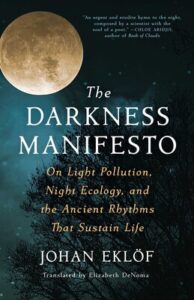In the twilight, bats, which nest in the old church of Suntak in Sweden, fly around, hunting for insects. The twelfth century church’s façade is not lit up at night. So, as in the past, the church remains a sanctuary for bats, remarkable creatures which have evolved to function in the dark.
In his book The Darkness Manifesto, originally published in the Swedish two years ago, Johan Eklöf, bat scientist and conservationist, makes the case that when lights are on around the clock, in cities, the countryside or even offshore, the circadian rhythm of all beings on earth changes. While nocturnal animals are the most affected by excessive lighting, few creatures on the planet remain unaffected.
Early in the 21st century, astronomers were the first to notice light pollution and establish a scale to assess the level of superfluous artificial light in observing sites. They established the Bortle scale of light pollution ranging from 1 (none, as in the middle of the ocean) to 9 (inner-city level). Skyglow, the illumination of the sky thanks to light pollution, impacts professional stargazing and obscures an urbanite’s view of the night skies – just as if a careless individual had “used a dirty cloth to wipe the window facing the universe.”
Biologists started studying how always-on artificial light disrupts organisms. Some life forms that take their time cues from the moon seemed clearly off: birds singing in the middle of the night, baby turtles heading off in the wrong direction. Research findings on how light pollution impacts entire species and ecosystems are still emerging.
Take the case of insects –nearly 40 percent of insect species face extinction. To anyone who has ever seen an insect react to light, it is obvious that light pollution is a major cause, the author writes. Moths, which are nocturnal, are particularly vulnerable. In the pre-industrial era, moths were proverbially drawn to flames. Now, they are fatally drawn to bright lights. Like daytime bees, nocturnal moths are pollinators, and, in fact, they even visit more kinds of flowers than bees do – so moth decline is bad news.
What of humans themselves, the creators of electrical lighting? White light, from LEDs and fluorescent bulbs, has a greater proportion of blue wavelengths compared to incandescent bulbs. Over-exposure to this blue-tinged light has been linked to human ailments ranging from disrupted sleep patterns to a greater incidence of hormone-sensitive cancers.
Recognizing these health risks, Sweden’s Karlstad Central Hospital recently invested in indoor lighting that mimics the natural variation in both color and intensity. This successful model, the author writes, suggests that through thoughtful design we can regulate the amount of light to meet the human need for both light and darkness.
The LED, inexpensive energy-efficient technology which also led to a proliferation of outdoor lights, could also be a solution to our excesses, he writes optimistically. Today, light can be controlled, programmed in a way that was not possible with the incandescent light bulb. So, with greater awareness, some legislation, and a host of better-designed lighting products – motion-activated lights, downward-facing light sources and the like – we can reduce the amount of artificial light scattered into the atmosphere.
Light pollution may have a simple technical fix, but there are other factors to consider. Throughout our evolutionary history humans have been afraid of the dark, and culturally, we now consider light as a symbol of prosperity. In succinct chapters, the author lays out the psychology, philosophy, and politics behind the rampant spread of illumination.
From mythologies to modern religion, God has evoked the light, is the light, and all that is good in the world, he writes. In a literal, moral, and metaphorical sense darkness is considered the enemy as if “its proximity is an assault to our existence.” Embracing the darkness is therefore not going to be easy.
But even before you finish this book, with its many references to Scandinavian locales, some evening, you will step out of your home at dusk. All at once, you will become acutely aware of the wasteful lighting in your own neighborhood. Luckily, the last chapter is an actual manifesto of actionable points to befriend the darkness, which, the author assures us, is “merely a train trip, a walk, or a turned-off phone away.” He asks us to notice how the sun gives way to the moon and the stars – to take ourselves into the dark nights of midwinter and the mythical northern lights if we can.
From turning off the lights when we leave a room to allowing our backyards to rest in darkness at night or becoming full-blown light pollution activists, we can all do our bit to try to save this spottily, but still too brightly lit planet.
A version of this appeared in the New Scientist. pdf.
